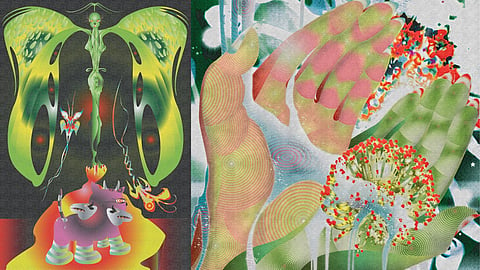How Firpal Jawanda's Indo-Futurist Art Was Shaped By Their Own Diasporic Experiences
Firpal Jawanda's lavish illustrations are a paradox, simultaneously rooted in the traditions of the past and reaching towards a fantastical future. A diasporic artist with a multifaceted practice is creating plush chimeric dreamscapes that bridge the gap between abstracted South Asian folklore, mythologies, and modern creature imagination.
In a fascinating conversation, Firpal Jawanda reveals how their cultural background and diasporic experiences fuel their art, which effortlessly blends storytelling and activism with an original fusion of folklore and futurism, all the while being driven by a constant fascination with reimagining chimeric creatures.
Could you elaborate on a specific project or series where you consciously navigated themes of diaspora and cultural identity?
‘fen assembly’ was a project were I was commissioned to create a drawing for Blackflyzine, a publication that centres sexual health for BIPOC people. With themes of submerging and shame I chose to focus the drawing on the ‘Aleya’ folklores. In these oral histories from fisherman in West Bengal and Bangladesh they talk of these ghost-lights that represented drowned fishermen that would appear in Marshes and swamps in the Western Ghats. These lights were thought of as unsatisfied spirits that would confuse and distract you, submerging you underneath the waters in that process. Focussing in on that plummeting feeling, I wanted the piece to be that moment of solace and meeting with oneself in the dark, behind closed doors deep within oneself to reflect on shame, secrets and possibility. I thought the imagery of a swirling sinking mangrove, with the Aleya personified and meeting with the large totalising figure, the monolith would capture that substance of being in secluded assembly with oneself.
From an overview of your work, you seem to blend abstracted South Asian folklores and indofuturisms into plush, chimeric fantasies. How do these cultural elements influence and shape your creative process?
In terms of these cultural elements influencing my creative process, I would take visual inspiration from the accompanying paintings and illustrations to these tales. These two dimensional, vibrant gradient and ensemble depictions in Kalighat, Thangka and Mughal miniature painting influences the scenescapes in both its planarity and use of colour.
Naturally themes of diaspora came up because I initially was acutely preoccupied with chimeric imagery which I grew up on. On one side I was seeing religious and cultural images at home but on the other I was playing Pokémon games, duelling with Yugioh cards, watching Digimon. I was obsessed with Merle in Escaflowne, Zoids etc. In ‘Crescent sky nights display cabinet’ I was combining images of traditional creatures like ‘Makara’ and ‘Sharabha’ with contemporary chimeric icons like ‘Furbies’ and ‘My Little Pony’. I presented them in this shop’s display cabinet, pointing at the merchanidis-ation of chimeric creatures today and highlighting my relationship with this imagery as both childhood entertainment nostalgia and taught religious culture.
How has your initial focus on chimeric imagery evolved into your current artistic direction of speculative fiction?
As a road map, that interest in chimera lead me down the road of researching different creatures and then to folklore in general. However, my work recently is less involved in specific narratives of Indian mythology and histories and more experimenting with my own speculative fictions and need for some indofuturist fantasy in this world.
Your involvement in various exhibitions, residencies, and collaborations, such as the Women's History Museum Biennale and SouthAsia.art residency, showcases a multifaceted engagement with different spaces and cultural contexts. How has this exposure to diverse environments and movements informed your understanding of diaspora experiences?
I interned for Women’s history museum while I was at uni, it is where i learned to trust my voice, where i think I was becoming for the first time inventive and outwardly creative. Directly after that experience I made my first and only fashion collection that was based on my new found interest in chimera.
Counter to that The South Asia art residency became a reflective project because I focused on researching the history of South Asians in London’s rag trade and trade unions in Old street. Part of that process involved lengthy interviews with my Nana Ji before his passing. I got to know in depth for the first time a lot more about his life as an immigrant working as a pattern maker (forced out because of racism). Eventually I would join that industry two generations later, I never knew about his past there until after i applied for fashion university. That experience gave so much personal contextual knowledge on being part of the diaspora here in the uk and the hurdles and tragedies that go unsaid with it, particularly from our elders.
Could you share your perspective on merging art, activism, and cultural identity? How do your collaborations reflect your vision for social change and representation within the diaspora community?
Part of print history is its usefulness as a tool to visually communicate protests and demonstrations, fundraise and organise. SeedSawa was one of the first times I was contacted to create prints in an effort to fundraise for a cause. This cause in particular was paramount as I am Sikh, Punjabi and raising money for Punjabi famers in resistance to the privatisation of India’s agricultural sector was all I was reading about at the time and furthermore I have been following this plight for most of my life. I find most articulation about the diaspora to be a little too sensational in a romanticised longing for the homeland, so when a practical collaboration or cause comes along like this its always welcome.
Follow Firpal Jawanda here.
If you enjoyed reading this, here's more from Homegrown:
Kitschy Couture's 'Buttercream Fantasy' Collection Celebrates Diasporic Identity
A New Gallery Dedicated To South Asian Diasporic Art Is The First Of Its Kind In The UK
Inside The Secret Daytime Raves That Provided Space for Diasporic South Asians


